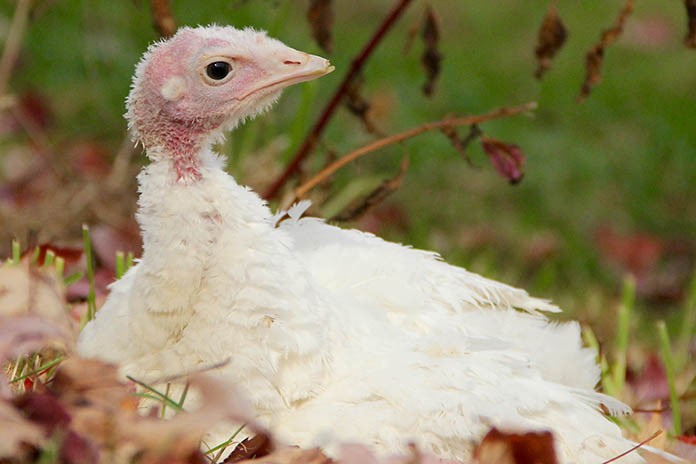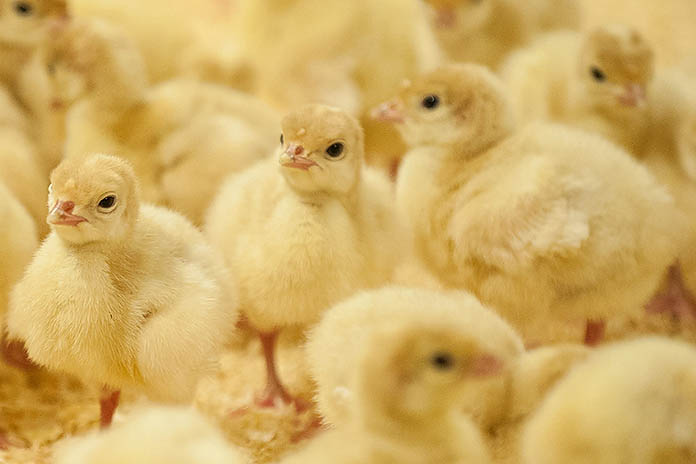
It is well known that cryopreserved semen could be used to regenerate commercial or research poultry lines; however, fertility rates from poultry semen frozen with current methods are not reliable enough for germ-line retrieval, especially from lines with low reproductive efficiency.
As part of a long-term research plan to determine how and why poultry sperm lose functional competence during hypothermic semen storage, several factors have been identified that may help to improve poultry sperm cryopreservation. This systematic approach to delineate the physiology responsible for poor sperm cryosurvival, and thus provide mechanisms to improve sperm cryopreservation, does not address the immediate need for preservation of germplasm from poultry stocks that are currently “at-risk”. To provide a short-term solution for preservation of semen from “at-risk” poultry lines, we are investigating an alternative strategy in the form of temporary dietary modification and/or in vitro manipulation of membrane cholesterol that also should be useful for the long-range goals of improving poultry sperm cryopreservation. Specifically, the goals are to:
1) Alter the fat source in the diet to improve cryosurvival of turkey sperm by modifying the sperm membrane lipid composition;
2) Change the cholesterol:phospholipid (C:P) ratio in the sperm membrane to improve sperm cryosurvival;
3) Determine if the combination of diet modification and in vitro manipulation of cholesterol content has a synergistic effect on sperm cryosuvival.
Poultry sperm membrane phospholipids
Phospholipids represent the main lipid type found in avian sperm membranes, with phosphatidylcholine comprising ~40% of the total phospholipid content. Poultry spermatozoa also contain a high proportion of poly-unsaturated fatty acids (PUFAs) in the plasma membrane. PUFAs are classified as n–3 or n–6 based on the location of the last double bond relative to the terminal methyl end of the molecule. While the plasma membranes of mammalian spermatozoa contain mainly n-3 PUFAs such as docosahexaenoic acid (22:6n-3; DHA), the phospholipids in avian spermatozoa are enriched mainly with n-6 PUFAs, including arachidonic (20:4n-6; AA) and docosatetraenoic (22:4n-6; DTA) acids. It has been proposed that the functional significance of this n-6/n-3 dichotomy in fatty acid profiles of avian and mammalian spermatozoa may represent an adaptation to temperature. The higher body temperature of birds (41ºC) compared to mammals (37ºC), in tandem with the fact that avian testes are internalized, requires avian spermatozoa to develop and function in a considerably warmer environment. The major PUFA of avian spermatozoa, DTA, displays the same chain length but fewer double bonds than the mammalian PUFA counterpart DHA; this difference in the degree of polyunsaturation provides a means for maintaining the appropriate biophysical properties of sperm membranes at the different body temperatures.
The biophysical characteristics of the sperm plasma membrane are influenced by both the C:P ratio and the fraction of phospholipids containing PUFAs. The “fluidizing effect” of the fatty acids is balanced by the “rigidifying effect” of membrane cholesterol, thus reducing the C:P molar ratio increases the fluidity of the sperm plasma membrane. Increased PUFA concentrations have been associated with increased sperm membrane fluidity in human and chicken spermatozoa. Moreover, phospholipids appear to be unevenly distributed throughout sperm cell. Large differences in membrane lipid composition have been shown between the head and tail regions of human spermatozoa, where 99% of DHA and the cholesterol precursor desmosterol were located in the tail.
Membrane damage is one of the main causes for the reduced motility and fertility of frozen/thawed spermatozoa. Plasma membrane lipids respond to temperature changes by altering their physical state, and these lipid phase transitions have been implicated in the fluidity of the sperm cell membrane during the cooling and warming stages of the cryopreservation cycle.
Additionally, alterations in the lateral organization of lipids within the bilayer have been attributed to phase separations during cryopreservation. High levels of membrane PUFAs also render poultry spermatozoa vulnerable to lipid peroxidation during hypothermic storage, where normal by-products of oxidative metabolism form free radicals that are extremely toxic to spermatozoa. It has been shown that membrane-bound phospholipids, especially phosphatidylcholine, decrease during hypothermic storage of chicken and turkey spermatozoa, with a 20% loss in phospholipid content of turkey spermatozoa occurring between 1 and 4h at 4°C.

Dietary modulation of the sperm plasma membrane
Long-chain PUFAs of the n-3 and n-6 series cannot be synthesized by vertebrates and therefore must be obtained from the diet, typically from plants in the form of the 18-carbon precursors α-linolenic or linoleic acid or from the long-chain derivatives (20–22 carbons) found in animal tissues. Dietary fats rich in n-3 PUFAs include fish and linseed oils, while soybean, corn, arasco and evening primrose oils are sources for n-6 PUFAs. All of these supplements have been investigated in poultry diets with the goal of modulating the lipid content in spermatozoa. Dietary supplementation with fish oil (source of n-3 PUFAs) has been shown to increase the DHA content of both chicken and turkey spermatozoa; however, linseed oil did not alter the DHA content in chicken spermatozoa. Interestingly, the total amount of PUFAs in spermatozoa was found to be similar among control and the n-3 supplemented diets; thus the increased level of n-3 PUFAs was offset by a reduction in n-6 PUFAs, particularly AA and DTA. Similarly, dietary sources of n-6 PUFAs, including soybean, corn, arasco and evening primrose oils, have been shown to increase the DTA content of chicken spermatozoa. To date, dietary sources of n-6 PUFAs have not been evaluated in turkey diets.
Inclusion of n-3 and n-6 oils in poultry diets has been shown to not only alter the phospholipid content of the sperm membrane, but also affect semen quality and fertility. Supplementation of turkey diets with 2% fish oil yielded moderate improvement in sperm viability but no improvement in fertility; whereas use of 5% fish oil not only effectively increased sperm membrane n-3 PUFAs throughout the production period, but also had a significant effect on the reproductive capacity of commercial flocks, including improved fertility, embryo viability and hatchability. Similarly, lower percentages of dietary fish oil (1-2%) yielded no measurable improvement for rooster semen quality, while 5% fish oil increased semen volume and sperm concentration, as well as fertility. Linseed oil, the other source of n-3 PUFA, had no effect on rooster semen quality, even with levels as high as 6%. Soybean and arasco oils have been evaluated as sources of n-6 PUFAs in rooster diets, and concentrations of 5% were associated with increased sperm concentration and fertility. Conversely, dietary corn and evening primrose oils both had negative effects on rooster sperm concentration, semen volume and total spermatozoa produced and fertility), irrespective of the level of oil in the diet (2-5%).
Because of the natural susceptibility of avian spermatozoa to lipid peroxidation, it follows that manipulation of sperm lipids would require enhanced antioxidant protection. The positive effects of the diets described above were dependent on use of vitamin E in higher levels than found in standard poultry diets. Vitamin E is the major lipid-soluble antioxidant present in cell membranes and plays a crucial role in breaking the chain reaction of peroxidation. This antioxidant is abundant in mammalian and avian spermatozoa, and was first identified in turkey spermatozoa over 20 years ago. The high levels of AA and DTA fatty acids in avian spermatozoa provide ideal conditions for the incorporation of vitamin E into the membrane structure. A series of experiments clearly demonstrated that the increase in concentration of vitamin E in spermatozoa was proportional to the amount of dietary vitamin E.
Further, a highly significant negative correlation was observed between vitamin E content and the susceptibility of spermatozoa to lipid peroxidation. It has been demonstrated that when the sperm content of vitamin E is increased, a rearrangement of PUFAs also occurs: the proportions of saturated, monoenoic and linoleic fatty acids decrease, while the proportions of AA and DTA increase. Standard chicken diets are formulated to contain 70 mg vitamin E/kg, while standard turkey diets contain 60 mg/kg. Based on the literature, the most effective dose for chicken spermatozoa is 200 mg vitamin E/kg feed, while a range from 120-200 mg/kg is beneficial for turkey spermatozoa. It is notable that the vitamin E content of turkey sperm was more than doubled by supplying 120 mg/kg of feed to the males. Most importantly, the effectiveness of PUFA-enriched diets is correlated with the level of dietary vitamin E.
Another natural antioxidant system in semen relies on the enzyme glutathione peroxidase, which is found in the avian testis, seminal plasma and spermatozoa. The major role of this selenium-containing protein includes reduction of peroxides to water and alcohols, an important step in preventing lipid peroxidation. Boosting selenium levels of rooster diets to 0.3 ppm (from the traditional 0.1 ppm) stimulated glutathione peroxidase activity in seminal plasma, spermatozoa, testes, and liver and increased sperm concentrations of selenium. Increasing dietary selenium from 0.1 ppm to 0.4 ppm prevented the loss of sperm membrane phospholipid that is associated with semen storage at 4ºC in turkeys. Moreover, a dietary combination of selenium and vitamin E was the most effective in reducing lipid peroxidation in chicken spermatozoa.
In vitro manipulation of sperm plasma membrane cholesterol
Reducing the C:P molar ratio increases the fluidity of the sperm plasma membrane. Sperm membrane fluidity has been shown to vary significantly among avian species, with anisotropy or membrane rigidity values in fresh semen ranging from 0.155 ± 0.016 in the chicken, to 0.180 ± 0.017 to turkey, to 0.205 ± 0.009 in the guinea fowl. In other words, chicken spermatozoa exhibit higher membrane fluidity than turkey spermatozoa, which might explain why chicken spermatozoa tend to survive cryopreservation better than turkey spermatozoa. Further, cryopreservation has been shown to increase anisotropy values and hence membrane rigidity proportionally for both species. In that same study, cryopreservation had a minor effect on the proportions of each lipid class in chicken spermatozoa, but dramatically increased the proportion of phospholipids in turkey spermatozoa. As a consequence, the C:P ratio was decreased by approximately 65% in turkey spermatozoa after cryopreservation.
Incorporation of cholesterol into cell membranes has been reported for many cell types, including spermatozoa from a variety of species. In vitro manipulation of membrane cholesterol is accomplished using cyclodextrins, low molecular weight carbohydrates with toroidal structures formed by 6-8 glucose residues that surround a hydrophobic center. Cyclodextrins function as carrier molecules and dissolve lipophiles in their hydrophobic core. A mechanism for improved cryosurvival after addition of cholesterol to the plasma membrane may involve elimination of the lipid phase transition, or at least lowering the temperature at which the sperm plasma membranes undergo the transition from the fluid to the gel state as the cells are cooled.
A more recent study demonstrated that adding cholesterol (using CLC) to stallion sperm membranes altered the osmotic tolerance limits and membrane permeability characteristics of the spermatozoa, thus reducing the amount of osmotic stress endured by stallion spermatozoa during cryopreservation.
In summary, the literature demonstrates that methodology exists to modify the lipid and cholesterol component of the sperm plasma membrane and strongly supports altering membrane lipids and/or cholesterol as a means of influencing membrane fluidity. Although membrane fluidity has been directly implicated in the cryotolerance of spermatozoa from many species including poultry, the potential to modify the sperm plasma membrane to improve the cryosurvival and post-thaw function of poultry spermatozoa is an intriguing possibility that has been largely overlooked.
References are available on request.
From the Proceedings of the 2016 Australian Poultry Science Symposium

















